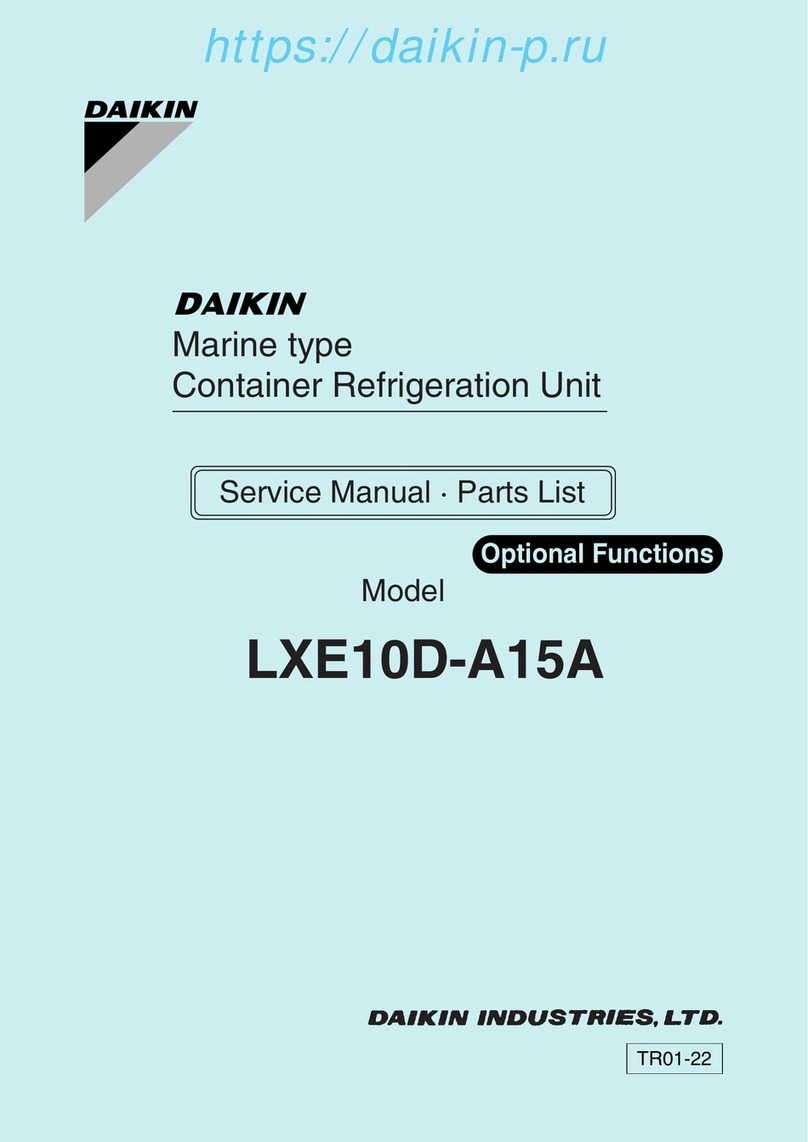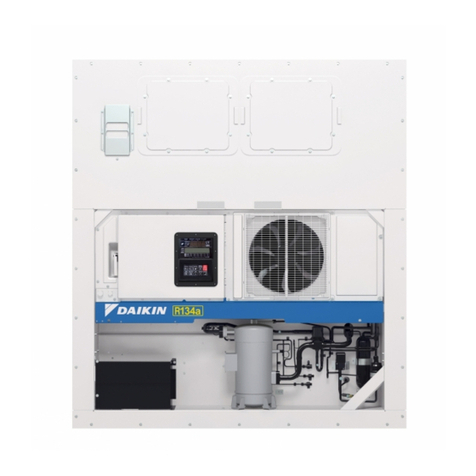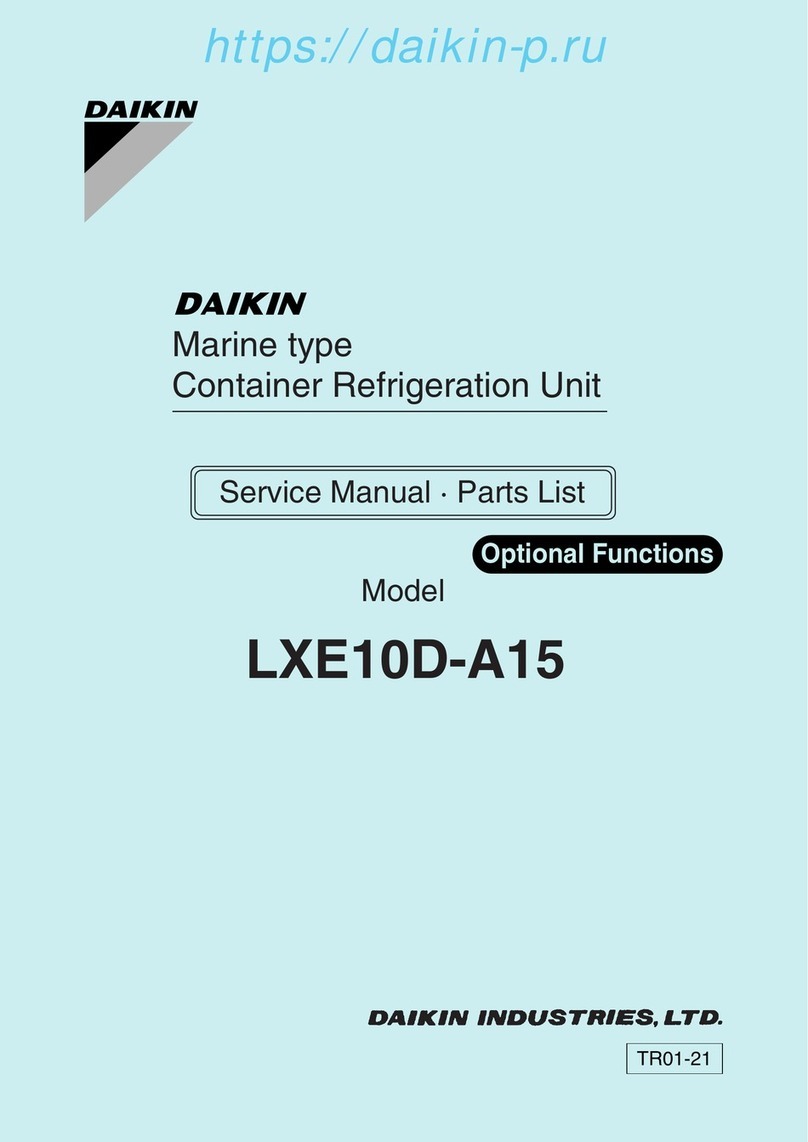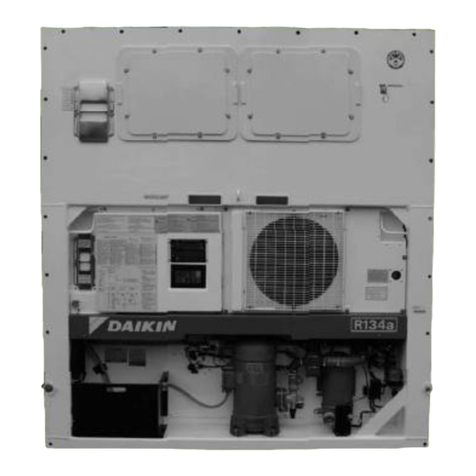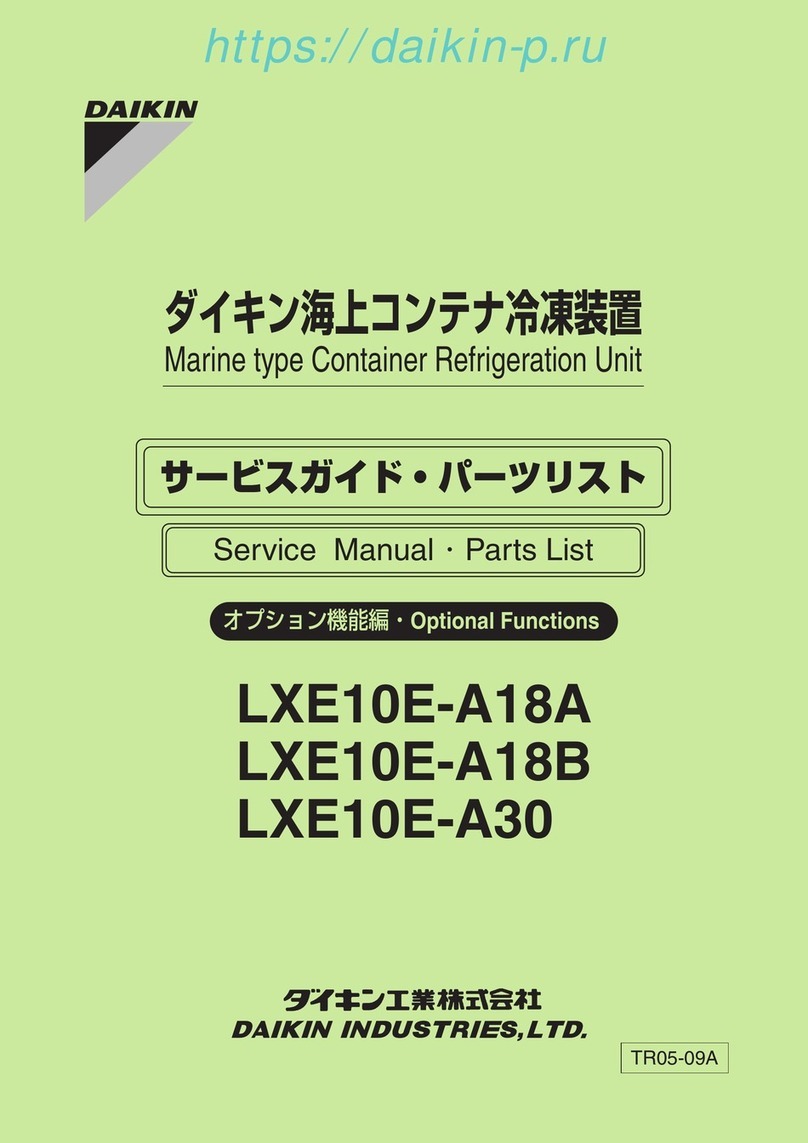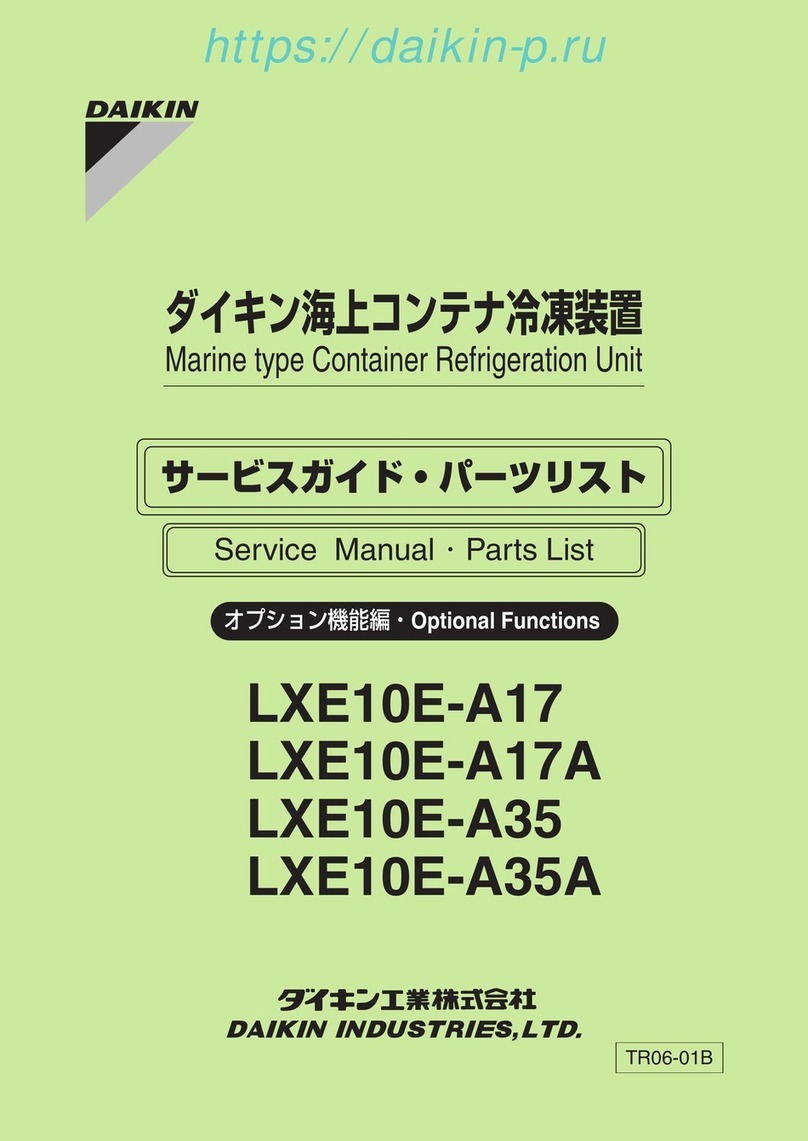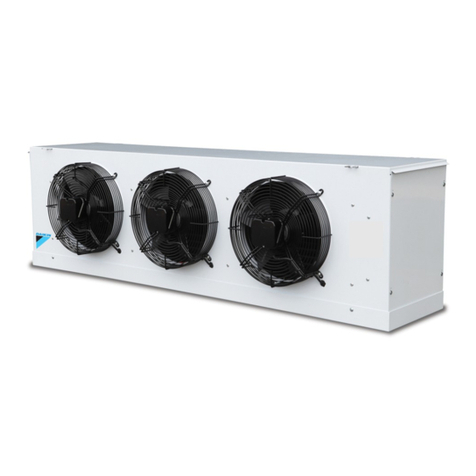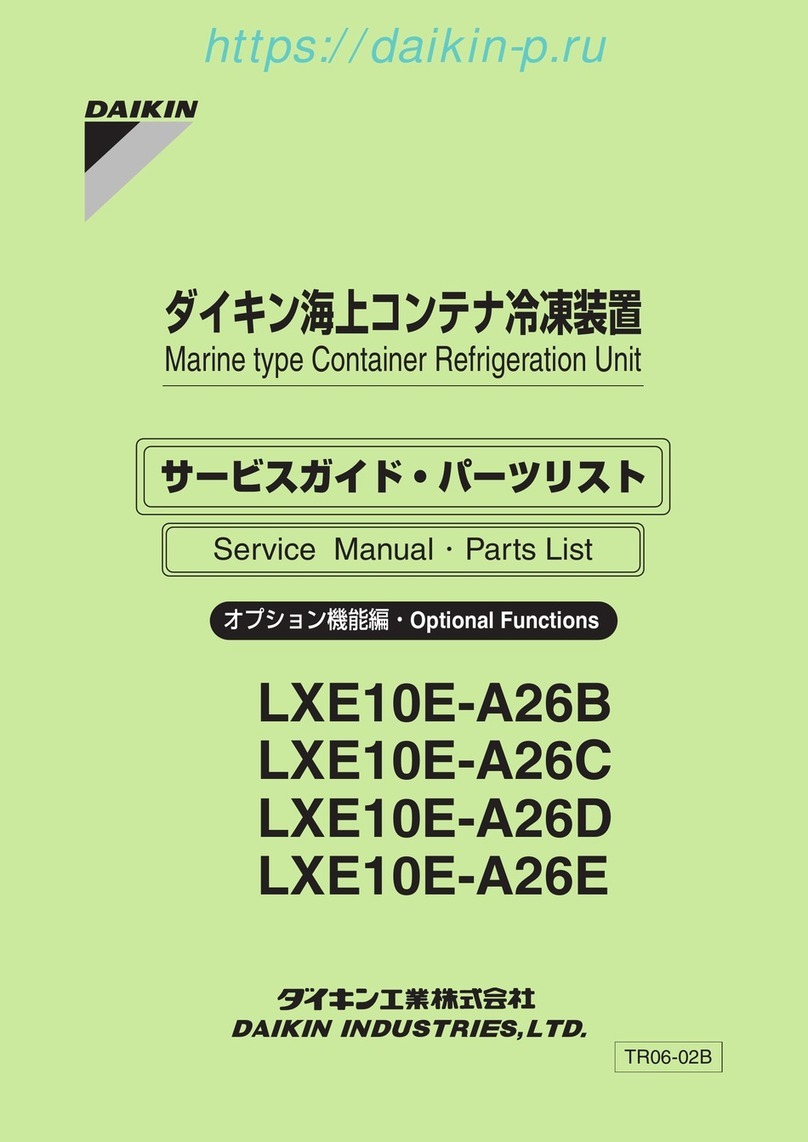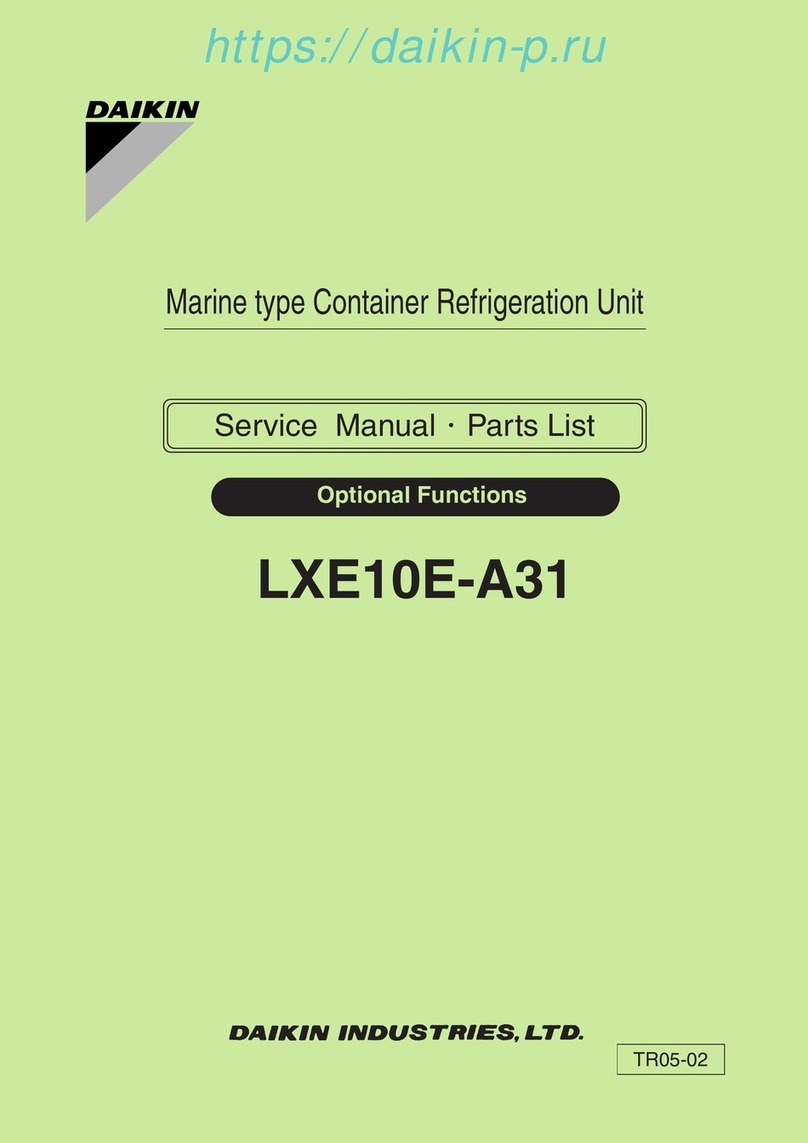
2
CONTENTS
3.10.1 Chart indication mode ........................3-57
3.10.2 P code (Pull down time indication) .....3-59
3.10.3 Chartless code display function..........3-60
3.10.3.1 List of chartless codes.................3-60
3.10.3.2 H-code.........................................3-61
3.10.3.3 d-code: ........................................3-63
3.11 Communication modem ............................3-64
4. Service and Maintenance .................................4-1
4.1 Maintenance service .....................................4-1
4.1.1 Collection of refrigerant ..........................4-1
4.1.2 Gauge manifold ......................................4-1
4.1.3 Automatic pump down............................4-3
4.1.4 Refrigerant recovery and charge............4-5
4.2 Main components and maintenance .............4-9
4.2.1 Scroll compressor...................................4-9
4.2.2 Fan and fan motor ................................4-15
4.2.3 PT and CT board (EC9756) .................4-16
4.2.4 Electronic expansion valve...................4-17
4.2.5 Thermostatic expansion valve..............4-18
4.2.6 Suction modulation valve .....................4-19
4.2.7 Drier......................................................4-20
4.2.8 Solenoid valve ......................................4-21
4.2.9 Discharge pressure regulating valve ....4-22
4.2.10 Check valve........................................4-22
4.2.11 High-pressure switch (HPS) ...............4-23
4.2.12 Low pressure transducer (LPT)..........4-23
4.2.13 High pressure transducer (HPT) ........4-24
4.2.14 Water pressure switch (WPS) ............4-24
4.2.15 Humidity sensor..................................4-24
4.2.16 Ventilation port opening degree sensor
(FA sensor) ........................................4-25
4.2.17
Air-cooled condenser and evaporator
...4-25
4.2.18 Water cooled condenser ....................4-26
4.2.19 Fusible plug ........................................4-26
4.2.20 Liquid/moisture indicator ....................4-26
4.2.21 Evacuation and dehydrating...............4-27
5. Additional Devices............................................5-1
5.1 USDA transportation .....................................5-1
5.1.1 Type of USDA sensor/receptacle ...........5-1
5.1.2 Initial setting ...........................................5-1
5.1.3 USDA sensor calibration ........................5-1
5.1.4 USDA transportation requirement ..........5-1
5.1.5 USDA report ...........................................5-1
6. Troubleshooting................................................6-1
6.1 Refrigeration system and electrical system...6-1
6.2 Alarm codes on electronic controller .............6-5
6.3
Troubleshooting for automatic PTI (J-code)
...6-10
6.4 Emergency operation ..................................6-12
6.4.1 Emergency operation of controller .......6-12
6.4.2 Short circuit operation of controller.......6-13
6.4.3 Opening adjustment of electronic
expansion valve....................................6-14
6.4.4 Emergency operation of suction
modulating valve ..................................6-15
6.4.5 Automatic Back up for supply / return air
temperature sensors ............................6-16
7. Appendix............................................................7-1
7.1 Standard tightening torques for bolts ............7-1
7.2 Standard tightening torques for flare nuts .....7-1
7.3 Standard tightening torque for stop valve .....7-1
7.4
Resistance of motor coil and solenoid valve coil
...7-2
7.5 Standard tightening torque for electronic
expansion valve coil (EV coil) .......................7-2
7.6 HFC134a, temperature-vapor pressure
characteristics table ......................................7-3
7.7 Temperature sensor characteristics table .....7-4
7.8
Temperature sensor characteristics table DCHS
...7-5
7.9
High pressure transducer characteristics table
...7-5
7.10
Low pressure transducer characteristics table
.7-5
7.11 Piping diagram ............................................7-6
7.12 Pilot lamps...................................................7-7
7.13 Fuse protection table...................................7-8
7.14 Schematic wiring diagram .........................7-10
7.15 Stereoscopic wiring diagram .....................7-11
Safety Precautions
• Danger .................................................................3
• Warning................................................................4
• Caution.................................................................5
1. Introduction .......................................................1-1
1.1 Operation range ............................................1-1
1.2 Basic Names of components ........................1-1
1.3 Basic operation of refrigeration unit ..............1-2
1.3.1 Operation preparation ............................1-2
1.3.2 Starting operation ...................................1-3
1.3.3 Checking during operation .....................1-4
1.3.4 Procedure after operation.......................1-4
1.3.5 Adjust the ventilation ..............................1-5
2. General description ..........................................2-1
2.1 Main specifications........................................2-1
2.2 Names of components ..................................2-2
2.2.1 Outside ...................................................2-2
2.2.2 Inside......................................................2-4
2.2.3 Control box .............................................2-6
2.3
Set point of functional parts and protection devices
...2-9
2.4 Operating pressure and running current .....2-10
2.5 Operation modes and control......................2-14
2.5.1 Frozen mode ........................................2-15
2.5.2 Chilled mode ........................................2-17
2.5.3 Defrosting mode ...................................2-19
2.5.4 Dehumidification...................................2-22
2.5.5 Common control ...................................2-23
3. Electronic Controller.........................................3-1
3.1 Function table................................................3-1
3.2 Basic operation of electronic controller .........3-3
3.2.1 Control panel ..........................................3-3
3.2.2 Operation mode and control...................3-5
3.3 Operation procedure .....................................3-6
3.3.1 Operation procedure flow chart ..............3-6
3.3.2 Mode operation procedure .....................3-9
1. Current indication mode .........................3-9
2. Operation setting mode ........................3-10
3. Battery mode ........................................3-11
4. Mode operation ....................................3-12
5. LED display light-OFF mode ................3-15
6. Sensor indication mode........................3-16
7. Temperature record scroll mode ..........3-19
8. Alarm record scroll mode .....................3-22
3.3.3 Setting flow chart..................................3-24
10. Optional function setting mode...........3-26
11. Basic function setting mode ...............3-27
12. Optional condition setting mode .........3-29
13. Input data mode .................................3-31
14. Controller software download mode...3-32
3.4 Alarm display and back-up function ............3-33
3.4.1 Alarm list...............................................3-33
3.4.2 Back-up operation at sensor
malfunction ...........................................3-34
3.5 Battery.........................................................3-36
3.5.1 Specifications .......................................3-36
3.5.2 Function................................................3-36
3.5.3 Battery check........................................3-36
3.5.4
Battery replacement (Rechargeable battery)
...3-37
3.6
Information interchange with personal computer
...3-38
3.6.1 Data logging .........................................3-39
3.6.2 Software configuration..........................3-40
3.7
Inspection procedure for the electronic controller
...3-42
3.8 Controller replacement and initial setting ....3-43
3.8.1 Controller replacement .........................3-43
3.8.2 Initial setting & operation procedure.....3-44
3.9
PTI (Pre-Trip Inspection) and periodic inspection
...3-45
3.9.1 Inspection item .....................................3-46
3.9.2 Automatic PTI (Pre-Trip Inspection) .....3-49
3.9.2.1 PTI selection mode........................3-50
3.9.2.2 Short PTI (S.PTI)...........................3-51
3.9.2.3 Full PTI (F.PTI)..............................3-52
3.9.2.4
Alarm list during PTI (Pre-Trip Inspection)
...3-54
3.9.2.5 Manual check (M.CHECK) ............3-55
3.10 Chartless function .....................................3-57
☆
☆☆
☆
☆
☆
☆
☆
☆
☆
☆
☆
☆
001-030E-SM(LXE10E-1E)A42007.04.2713:29ページ2
